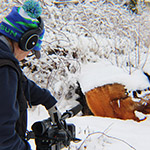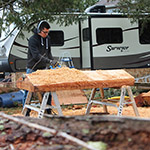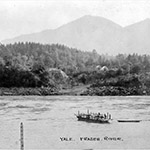The Kidnapping of Stó:lō Boys During the Fraser River Gold Rush
Canadians are increasingly aware of the tragic story of Indian residential schools; and the contemporary tragedy of missing and murdered Indigenous women and girls shows the ongoing vulnerability of Indigenous youth. But the story of Stó:lō First Nation "boys who were stolen away by… vicious white men" during the 1858 gold rush along British Columbia's Fraser River has been lost. These boys were kidnapped by American miners and taken to California. The vast majority "were never heard from" again, although at least two miraculously found their way home forty years later; and one ten-year-old boy lies buried in an unmarked grave in his kidnapper’s family plot in Sacramento’s pioneer cemetery. Families were devastated. One Stó:lō father "searched the woods for days… [and then] died of grief."

This story came from Keith Thor Carlson, a professor at the University of Saskatchewan and project coordinator for this episode. In his research, he had seen documents referring to Stó:lō boys being kidnapped during the Fraser River gold rush, a story unknown to members of the community. Building on Keith's research, the story was told through a house post carved by Coast Salish artist Terry Horne. His carving was installed in August 2017 on the banks of the Fraser River near Hope, BC. This site, provided by the Chawatil First Nation, was where one of the boys had been last seen. The story and Terry's creative process are featured in the film, Kidnapped Stó:lō Boys by Sandra Bonner-Pederson of the Tzeachten First Nation. The entire project was guided by a steering committee of Stó:lō educators, mothers, and cultural experts.
Credits
Artist
Terry Horne
Terry Horne is a Coast Salish artist with over 20 years experience. In addition to being an artist, Terry is also the chief of Yakweakwioose band, located in Chilliwack, BC. He carries the ancestral name of Siyemches, a name passed down to him by his grandfather Frank Malloway. Terry’s art-work has been exhibited in countries around the world by way of various galleries. His preferred artistic medium is wood, mainly red cedar, from which he carves house-posts, totem poles and masks.
Filmmaker
Sandra Bonner-Pederson
A member of the Tzeachten First Nation, Sandra Bonner-Pederson is Owner/Operator of Bear Image Productions, a video production company established in 2002 and located on the Tzeachten First Nation, near Chilliwack, BC. Starting in the television industry as a volunteer host for the First Nation program "Rebirth of a Nation", she went on to study at the British Columbia Institute of Technology, subsequently working at ITV and the Super-Channel/Family Channel. Upon returning to Chilliwack, she collected considerable videography and editing experience, before creating Bear Image Productions, whose work is featured on the company’s website. Sandra’s company produces a weekly program that airs on cable locally entitled "Bear Tracks." These 3-4 minute films form part of a larger project being produced for First Nation People. Bear Image Productions
Project coordinator
Keith Thor Carlson
Keith Thor Carlson is Professor of History at the University of Saskatchewan where he holds the Research Chair in Indigenous and Community-Engaged History. Prior to coming to the UofS he worked for a decade as historian for the Stó:lō Nation in British Columbia. There he collaborated with Knowledge Keepers to research the history and historical consciousness of Indigenous people and examine the history of settler colonialism. His research into the 1886 murder of a Stó:lō youth by an American lynch mob led to the documentary film The Lynching of Louie Sam (2004), and this in turn motivated the Washington State legislature to issues a formal apology to the Stó:lō community. In addition, he has authored six books, including the award winning The Power of Place, The Problem of Time: Aboriginal Collective Identity and Historical Consciousness in the Cauldron of Colonialism (2010), and edited or co-edited four additional books including The Stó:lō-Coast Salish Historical Atlas (2001) and Orality and Literacy: Reflections Across Disciplines (2011). With John Lutz (UVic) and colleagues at the Stó:lō Nation, Carlson offers the only graduate-level humanities-based Ethnohistory Fieldschool in North America. Recently he launched the Community-engaged History Collaboratorium where he facilitates partnerships with Indigenous, cultural, and heritage organizations to provide paid summer research internships to undergraduate students.
Making the Art
Historical Images
Teaching Lost StoriesThe Kidnapping of Stó:lō Boys During the Fraser River Gold Rush
Teaching Lost Stories consists of a set of lesson plans and historical documents that encourage critical thinking about the history that is literally all around us. Teachers and students consider why some stories from the Canadian past have been commemorated through historical markers such as monuments, while other stories have been ignored.
Material prepared by Keith Thor Carlson, professor of history at the University of Saskathewan, with the assistance of Jenna Casey and Brittany Gilchrist.
























